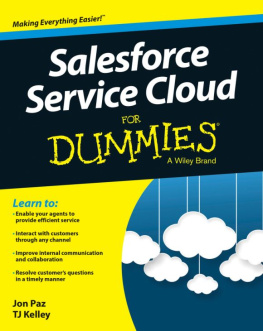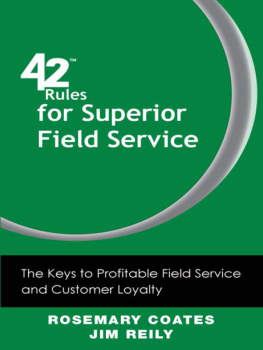Thank you to the staff at Service Quality Institute for providing the support both on the original book and this revised edition.
My family has provided ongoing support for my fanatical commitment to customer service. Thanks Pat, my wife of 34 years, Christina, and Matthew. My mother, Agnes Tschohl, who passed away in 2003, at the age of 102, gave me the self- confidence and self-worth to reach my goals.
Most importantly, I would like to thank the thousands of customers I have worked with over the last 39 years, who have helped me define this strategic customer service message.
Introduction
WHAT THIS BOOK WILL DO FOR YOU
If youve heard and read all you want to know about how bad service is in the world and how important service is to customers and to your bottom line, you may be ready for a little action. This is the 8th edition and has been updated with 2011 information.
After many recent articles and books dealing with the need for quality service, few business managers remain unconvinced. Many, however, remain unequipped to express their commitment in action. The mission of this book is to equip the already convinced to implement the already proved: service is a strategy as powerful as marketing and as potent as a quality product itself in the ongoing effort to realize the full profit potential of a company.
This book gives you detailed, step-by-step knowledge that you can use in establishing profitable customer service strategies.
The profit-producing capability of an organization derives from impressions made by all employees on the organizations customers. The means of creating these impressions are the quality and efficacy of the product or service that the employees sell: the quality, accuracy, dependability, and speed of their service and the warmth of their human relationships with customers. All employees, from CEOs to minimum-wage hourly workers (some more than others), influence a companys reputation and form the attitudes of customers both internal and external. Therefore, these employees especially front-line service employees must be trained to deliver service. The service mentality and the desire to provide service are not native traits. Once trained, employees motivation (commitment) must be renewed.
In 1979, long before customer service came into vogue, I designed a customer service training program that organizations could use to change the attitudes and the behavior of employees. This was my ninth year in the consulting and training business.
I saw organizations spend millions on advertising, trying to attract customers. But then they used baseball bats (figuratively) to drive them away. This was bizarre behavior, I felt. If these organizations would just provide good service, making their customers feel special, wanted, and appreciated, they would keep the customers their advertising attracted.
The learning system I developed in 1979 has been used by millions of people throughout the world. It is cost effective and user friendly, and it is written to be understood by the employee participants, not just management and trainers.
This book is written for managers for senior and middle managers who influence the service quality of a company by deciding what employees who deal directly with customers will do, how they will do it, and, initially, whether they will do it at all. They tell employees what is expected of them in terms of customer service; and they evaluate and report to them their service performance.
Service leaders and champions of service can use this book to drive a service strategy. Entrepreneurs who want to grow their businesses through a service culture will find these ideas valuable.
But, to imply from the significance of management in the service scheme that only management needs training would constitute a significantly counterproductive oversight, no matter how elegant the rationalization supporting it. The reason is that an estimated 95 percent of the factors that determine reputation of a company among customers and prospects are in the hands of front-line service employees. Even though a manager may harbor low esteem for the personal qualities of front-line workers, a grossly uninformed and unfair view, the fact remains that they still are primarily responsible for delivering service. They create impressions that form an organizations reputation. They especially must be trained. And money must be spent training them.
But, today, many organizations dont train front- line employees in service at all. Instead, they advertise that they have service. Apparently they hope that employees will read the ads and feel compelled to live up to the promise.
Training and motivation for people who actually deliver service and how-to-do-it implementation instructions are the twin I-beams supporting the substance of this book. They are:
The reason this book was written.
The features that distinguish this book from other books on service.
Among key benefits to readers of this book are:
Hands-on ideas, skills, and techniques that can be used immediately.
Knowledge about shaping employee attitudes, a powerful competitive force moving a firm toward greater market share, customer loyalty, and profitability.
HOW THIS BOOK IS ORGANIZED
The book presents information in building-block fashion. Each chapter helps you to understand and to use information that follows properly.
The first chapter presents facts and statistics and logical narrative to use in persuasive internal reports and memos on service. Chief among benefits of quality service itemized in Chapter 1 is the positive impact of service on the bottom line. Customer service is not an expense. It is a high-yield investment. World Class Service Role Models in Chapter 2, like GE, Home Depot, help us understand why service is critical.
Chapters 3 and 4 deal with getting started Chapter 3 with planning and Chapter 4 with organizing.
Chapter 5 presents essentials of a basic subject, knowing what your customers want in other words, knowing what you have to do to win their satisfaction and their continued patronage. This step is essential to the development of any companys service strategy. Know your customers. Factoring results of national surveys of consumer needs and wants into your plan simply isnt good enough.
A quality service program stalls quickly without employees to implement it aggressively. Thats why a chapter (Chapter 6) on finding service-minded employees is included. The message of Chapter 6 is that trainable employees with native service ability generally are born, not made (with exceptions).
But, even high-potential employees need to be re-motivated. So, we present Chapter 7, dealing with the function of employee motivation in a service strategy.
The following three chapters (8,9,10) are the meat and potatoes of the book. Herein lays information that a reader would need months or years to assemble from diverse sources. These chapters were brightened by ideas in action case histories from all over the country and the world.
Chapter 8 primes the readers imagination with treatment of essential loyalty-building service programs. Chapter 9 contains more basics of quality service from which readers can select practices most appropriate for their organizations. Chapter 10 covers projects with the most tangible, profit-making results results that even the most hard-nosed manager would admire. From this chapter should come the heavy-caliber ammunition for use in winning support for a service program of hesitant VIPs in the organization.
Once a program is underway, the next concern should be with maintaining momentum and with practicing preventive maintenance. According to Chapter 11, you must give a new service program a boost to get it up to speed, measure service performance, stay alert to customer dissatisfactions and eliminate them, and identify and perpetuate reasons for satisfaction.







